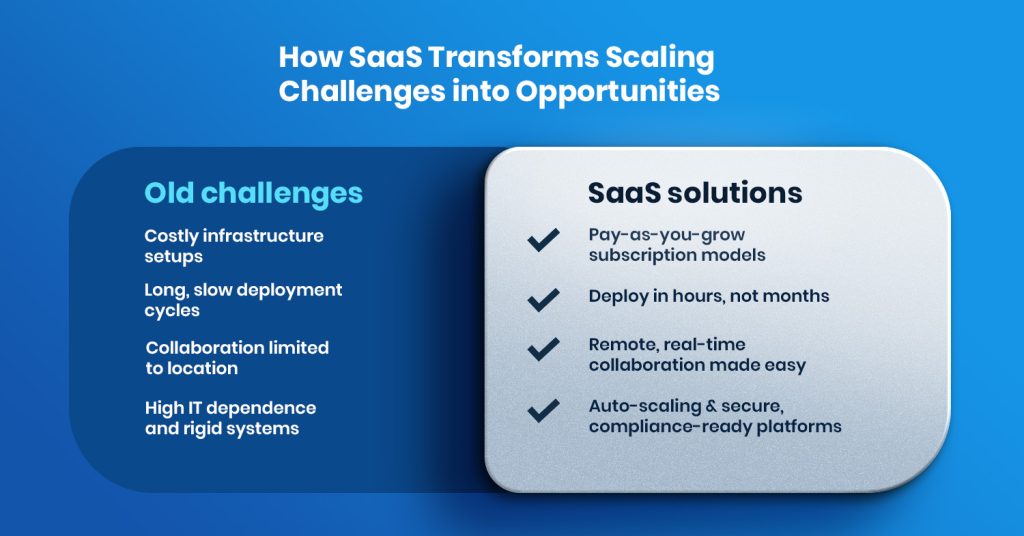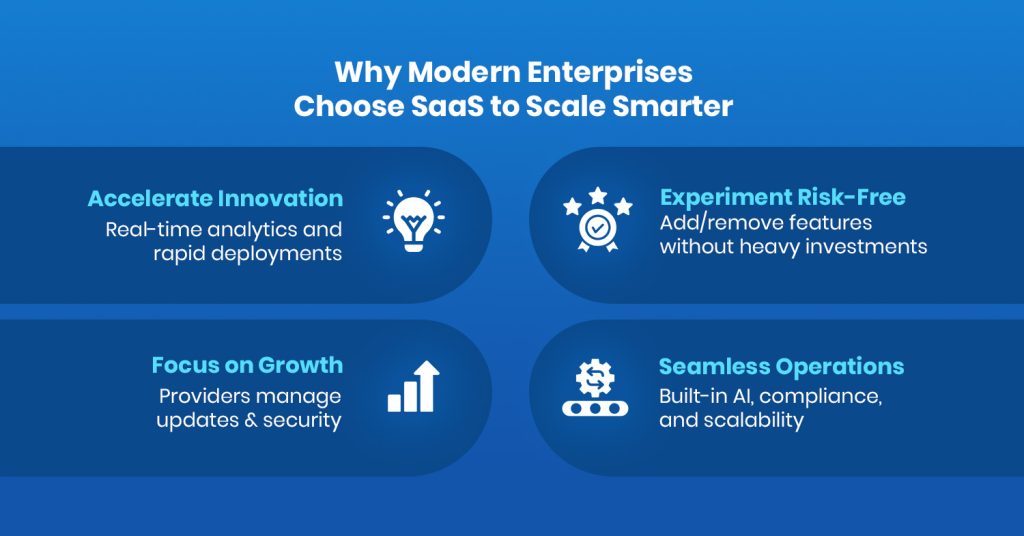SaaS Is Transforming the Way Companies Scale

India’s SaaS industry is projected to grow from $20 billion today to $100 billion in 2035, led by AI-driven automation, SMB adoption, and digital government initiatives. The growth highlights the disruption that Software as a service (SaaS) creates in technology and how new-age businesses scale.
SaaS services provide software via the Internet on a subscription model. In contrast to conventional software, which involves initial purchase, manual installation, and dedicated infrastructure, SaaS is cloud-based, regularly updated, and scalable by design.
This shift is turning traditional IT models upside down. Companies no longer have to spend much on infrastructure or wait months to deploy tools. SaaS management platforms provide agility, efficiency, and cost savings, drivers of sustainable scaling in today’s fast-paced digital economy.
What are the scaling challenges?
Before SaaS solutions, scaling was a slow and costly process, often limited by
- Cost-intensive infrastructure —Setting up and maintaining servers, storage, and licensing required significant capital investment.
- Time-consuming deployment cycles —Software rollouts used to take weeks or months, slowing down innovation and market responsiveness.
- Geographic and collaboration limitations —On-premise systems hindered remote work, global collaboration, and real-time updates.
- High IT dependency and rigid systems — Customizations were difficult, upgrades were risky for downtime, and scaling up usually meant re-architecting everything.
How do SaaS solutions help scale businesses?

a. Pay-as-you-grow flexibility
SaaS services eliminate initial CAPEX. Companies subscribe based on usage, scaling up effortlessly as they expand. The model is particularly valuable for India’s growing SMB market, where vertical SaaS can get a $13 billion opportunity.
b. Faster time to market
With plug-and-play architectures, organizations can implement SaaS solutions within hours, not months. Regular updates and feature drops remove long wait times, enabling businesses to have a clear advantage in innovation.
c. Borderless collaboration & remote enablement
SaaS software solutions are designed for an interconnected world. Teams can access the same tools and data remotely to collaborate in real-time using CRMs, project management tools, and communication software.
It is critical for digital-native companies, whose software expenditure will grow from $4.6 billion in 2025 to $26 billion in 2035, as they scale their remote-friendly businesses and customer experiences.
d. Built-in scalability and security
SaaS management platforms offer auto-scaling infrastructure, ensuring performance under heavy loads without manual intervention. Most are also cloud-native and compliance-ready, helping businesses meet regulatory frameworks like India’s Digital Personal Data Protection (DPDP) Act 2023 and RBI’s fintech security norms.
This shift is also fueling the cybersecurity SaaS market, which is set to surge from $1.6 billion to $10 billion, as data protection and automation tools become integral to scaling securely.
What is the competitive advantage for modern enterprises

SaaS solutions enable companies to:
- Accelerate innovation – Quick deployment and real-time analytics enable quicker decision-making.
- Experiment with low risk – Test new features or integrations without heavy investment.
- Shift focus from operations to growth – With infrastructure and maintenance done by providers, internal teams can focus on strategy and customer experience.
Future trends
The future evolution of SaaS services is already underway:
- AI/ML integration—Predictive analytics, intelligent automation, and personalized experiences will go mainstream.
- Vertical SaaS—Industry-specific solutions for BFSI, healthcare, and logistics will further develop, particularly as enterprise AI and cloud adoption contribute an additional $35 billion to the market.
- API-first ecosystems— Interoperability across SaaS platforms will uncover more value from systems and data.
- No-code/low-code growth – Enabling non-technical users to create workflows and applications without coding, speeding internal digital transformation.
Conclusion
Software as a service is more than a fleeting IT trend. It’s a strategic growth engine.
SaaS management platforms are transforming how companies scale today in every industry, from streamlining costs and deployment time to powering AI-driven efficiency and compliance with regulations.
ESDS allows businesses to grow with a diverse SaaS portfolio served through adaptive subscription models. Powered on the cloud and digital marketplace SPOCHUB, the products and services comprise
- eMagic (DC management), VTMScan (vulnerability scan), eNlight WAF, WebVPN, IoT, eNlight 360° hybrid cloud, Low-code Magic, and many more.
- Industry-specific platforms for lending, healthcare, education, and agriculture.
- Government-specific G-SaaS solutions for smart metering, e-governance, smart cities, and public sector cloud solutions.
- A unique pay-per-branch model for cooperative banks, providing core banking on SaaS with managed services.
ESDS SaaS solutions are designed specifically to enable organizations to scale effectively, securely, and intelligently.
With India’s SaaS market sprinting towards a $100 billion future, the question is no longer whether your business should be on a SaaS management platform; it’s how quickly you can scale with it.
- SaaS Is Transforming the Way Companies Scale - April 28, 2025
- Why no backup plans even after repeated global IT failures? - February 25, 2025
- Can BFSI community cloud solve data security challenges in banks? - February 3, 2025
